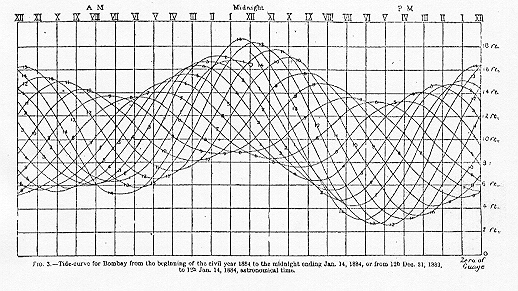Fourier Analysis of Ocean Tides I
2. Tides and gravitation

| From George H. Darwin's article "Tides," Encyclopaedia Britannica, IX Ed.,Chicago, 1890. Note that in this graph, time increases to the left. Larger image. |
Tides. This figure shows the tidal record for two weeks (January 1-14, 1884) at Bombay. The tide was recorded on a cylindrical sheet that turned once every 24 hours. Each daily curve is labelled with its date. Some obvious features:
- there are usually two high tides and two low tides each day;
- the tides come about 50 minutes later each day;
- during the two-week period there is considerable variation in the daily pattern of highs and lows;
- there is usually a difference in height between two consecutive high tides (the diurnal inequality).
Gravitation. The tides are caused by the gravitational fields of of the Sun, the Moon and the Earth, acting on the Earth's oceans.

| The yearly travel of the Earth around the sun, the monthly travel of the Moon around the Earth, and the daily rotation of the Earth on its axis are the three main rythms that govern the tides. (It is impossible to draw the Sun-Earth-Moon system to scale. To scale, the Sun is a basketball in the center of a football field, the Earth is the eraser on a pencil held on the sidelines, and the Moon is the tip of a straightened-out paper clip stuck in the eraser.) |
In fact the "tidal force" depends on the gradient of the gravitational field. Because (in the case of the lunar tide) what creates the bulge in the Earth's oceans on the side facing the Moon is the fact that the surface of the Earth is closer to the Moon than the center, and is therefore attracted more strongly. This also explains the bulge on the opposite side: there the center is closer than the surface. In general a variable gravitational field will stretch bodies along its gradient; our ocean tides are a special case of this effect.
Why the gradient? The gravitational force exerted by a body of mass m on a piece of matter at a distance L centimeters gives it an acceleration Gm/L2 cm/sec2, where G= 6.67x10-8dyne-cm2/g2 is Newton's gravitational constant.
Suppose another piece of matter is k centimeters farther in the same direction. Then it undergoes a smaller acceleration: Gm/(L+k)2 cm/sec2. The difference between these two accelerations can be ascribed to a ``tidal force" pulling the two pieces apart. The estimation of this difference is a classic example of the linear approximation f(x+k) - f(x) ~ k f'(x). It yields
-2 G m k --------- cm/sec2. L3
- This calculation explains why the Sun (m = 2x1033, L = 1.5x1013, m/L3= 6x10-7) and the Moon (m = 7.3x1025, L = 3.8x1010, m/L3=13.3x10-7) exert comparable tidal forces at the surface of the Earth.
Welcome to the
Feature Column!
These web essays are designed for those who have already discovered the joys of mathematics as well as for those who may be uncomfortable with mathematics.
Read more . . .
Feature Column at a glance




